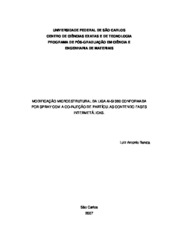| dc.contributor.author | Bereta, Luiz Antonio | |
| dc.date.accessioned | 2016-06-02T19:10:11Z | |
| dc.date.available | 2012-10-30 | |
| dc.date.available | 2016-06-02T19:10:11Z | |
| dc.date.issued | 2007-12-19 | |
| dc.identifier.citation | BERETA, Luiz Antonio. Microstructure modification of spray formed al-si 380 alloy with the CO-injection of particles containning intermetallic phases. 2007. 132 f. Tese (Doutorado em Ciências Exatas e da Terra) - Universidade Federal de São Carlos, São Carlos, 2007. | por |
| dc.identifier.uri | https://repositorio.ufscar.br/handle/ufscar/698 | |
| dc.description.abstract | The aim of this work was to determine the microstructure and the mechanical properties of a spray formed Al-Si 380 alloy in different conditions as follow: co-injection of particles containing intermetallic phases, extrusion and heat treatment in the deposits. The wear resistance was also evaluated. The microstructure was determined as a function of two different composition applied in the co-injection, two processing routes (spray formed with or without extrusion) and two heat treatment condition (present or not). The composition of the co-injection particles was selected aiming to improve the formation of α-Al(Fe,Mn)Si instead of β-Al(Fe,Mn)Si intermetallic, with Thermocalc program. The microstructure of the deposit was characterized by scanning electron microscopy (SEM) coupled with microanalysis (EDS) and the length of the needle-like phases (-Al(Fe,Mn)Si) was measured. The processing condition that formed the smallest average length of the -Al(Fe,Mn)Si was extruded and heat treated. An extra heat was processed with Mg addition in order to improve the precipitation hardening. The samples were tested in tension at room temperature, 100 oC, 200 oC e 300 oC. The wear tests were carried out at a sliding speed of 0,48 m/s and at the load of 500g, 800g and 1000g, in a 2,5 mm diameter samples. The co-injection of the particles containing the α-Al(Fe,Mn)Si phase was effective in decreasing the β-Al(Fe,Mn)Si phase length and promote the increase of the elongation values. The artificial aging heat treatment was effective in increase the yield and ultimate tensile strengths without decrease significantly the elongation. The Mg addition promoted an additional increase of the yield and ultimate tensile strengths. The wear tests show that no statistical difference was observed among the evaluated samples, according to test parameters selected. | eng |
| dc.description.sponsorship | Universidade Federal de Sao Carlos | |
| dc.format | application/pdf | por |
| dc.language | por | por |
| dc.publisher | Universidade Federal de São Carlos | por |
| dc.rights | Acesso Aberto | por |
| dc.subject | Ligas de alumínio | por |
| dc.subject | Conformação por spray | por |
| dc.subject | Coinjeção | por |
| dc.subject | Microestrutura | por |
| dc.subject | Compostos intermetálicos | por |
| dc.title | Modificação microestrutural da liga Al-Si 380 conformada por spray com a co-injeção de partículas contendo fases intermetálicas | por |
| dc.title.alternative | Microstructure modification of spray formed al-si 380 alloy with the CO-injection of particles containning intermetallic phases | eng |
| dc.type | Tese | por |
| dc.contributor.advisor1 | Bolfarini, Claudemiro | |
| dc.contributor.advisor1Lattes | http://lattes.cnpq.br/9231627080617037 | por |
| dc.description.resumo | Este trabalho teve por objetivo determinar a microestrutura e as propriedades mecânicas da liga Al-Si 380 processada via conformação por spray, em diferentes condições, a saber: co-injeção de partículas contendo fases intermetálicas, extrusão dos depósitos e tratamento térmico. Foi avaliada também a resistência ao desgaste. A microestrutura foi determinada em função de duas composições diferentes que foram empregadas para co-injeção, duas condições de processamento (conformado por spray com e sem extrusão) e duas condições de tratamento térmico (presente/ausente). A composição das partículas co-injetadas foi projetada objetivando a formação da fase intermetálica α-Al(Fe,Mn)Si em detrimento a β-Al(Fe,Mn)Si, com emprego do programa Thermocalc. Os depósitos da liga Al-Si 380 foram caracterizados por MEV/EDS e as fases com morfologia de agulha (β-Al(Fe,Mn)Si) foram mensuradas. A condição com menor comprimento médio das partículas da fase β-Al(Fe,Mn)Si foi extrudada e tratada termicamente, além de sofrer adição de Mg em uma das condições. O ensaio de tração foi realizado à temperatura ambiente, 100 oC, 200 oC e 300 oC. O ensaio de desgaste foi realizado a uma velocidade de 0,48m/s, sendo aplicadas três cargas diferentes: 500g, 800g e 1000g, em um corpo de prova de 2,5 mm de diâmetro. A co-injeção das partículas da fase α-Al(Fe,Mn)Si foi efetiva em diminuir o comprimento da fase β-Al(Fe,Mn)Si no depósito e levou ao aumento do alongamento até a fratura do material obtido. O tratamento térmico de envelhecimento artificial aplicado foi efetivo em aumentar os limites de resistência e escoamento sem, entretanto, implicar em diminuição significativa do alongamento até a fratura. A adição de Mg aumentou ainda mais os limites de resistência e escoamento. Os ensaios de desgastes evidenciaram que não existem, estatisticamente, diferenças significativas dentre as amostras avaliadas, segundo os parâmetros do ensaio empregado. | por |
| dc.publisher.country | BR | por |
| dc.publisher.initials | UFSCar | por |
| dc.publisher.program | Programa de Pós-Graduação em Ciência e Engenharia de Materiais - PPGCEM | por |
| dc.subject.cnpq | ENGENHARIAS::ENGENHARIA DE MATERIAIS E METALURGICA | por |
| dc.contributor.authorlattes | http://lattes.cnpq.br/8706833995243816 | por |
